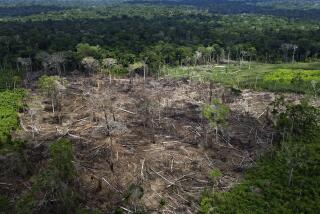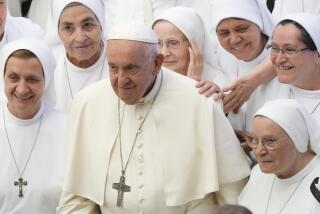How the pope is saving Earth
- Share via
Pope Benedict XVI, like many world leaders, has spoken passionately about the urgent need to protect the planet from climate catastrophe. But unlike his fellow heads of state, the pontiff has actually created a carbon-neutral economy -- and done it cheaply and quickly.
The Vatican announced last year that it would restore 37 acres of forest in Hungary that had been cut down in the Middle Ages. Those growing trees will absorb enough carbon dioxide to offset all the pollution from the fossil fuels used to power Vatican City.
The reason this “Vatican model” succeeded while other countries struggle to achieve even modest emissions reductions is because of the unique qualities of forest conservation and restoration. Compared with other methods of reducing climate-changing pollution, such as switching to wind, solar or geothermal power, it’s fast and relatively cheap. That’s true on a small, Vatican City scale as well as a massive American scale.
It’s particularly true when it comes to the carbon-rich tropical forests that act as the Earth’s lungs, breathing in carbon dioxide and breathing out oxygen. These forests are being logged and burned at a terrifying pace by big agricultural, biofuels and mining companies. Between August 2007 and April 2008, for instance, big ag and its cohorts destroyed a whopping 2,300 square miles of the Amazon, releasing 300 million tons of CO2 into the air in the process. Compounding that disaster, the treeless land generally loses its capacity to absorb the greenhouse gases produced by the world’s fossil fuel consumption.
The good news is that stopping that destruction -- by purchasing the land outright or paying landowners and others to conserve it -- is a bargain. Because of the low cost of tropical land, protecting these forests can cost as little as $1 per ton of CO2 saved and almost never more than $10 a ton. (For comparison, cleanups based primarily on energy now trade for more than $40 a ton on European markets.)
As a result, the World Bank and others estimate that global deforestation could be completely halted for the relatively tiny sum of $11 billion to $15 billion a year. That one move alone would eliminate 20% of total global warming pollution.
Despite the urgency of the problem -- and the ease of the solution -- forest conservation has, until recently, been the forgotten stepchild of climate legislation. For many years, policymakers (particularly in Europe) were nervous that polluters would abuse the system by using low-cost overseas forest conservation projects as an excuse to avoid cleaning up industrial pollution at home.
But forest conservation needn’t be an end. It should be a beginning. Again, we can look to the Vatican as a model. The pope didn’t stop with his Hungarian forest. This year, he’s planning to unveil an array of solar panels atop the huge Paul VI Audience Hall, which will provide enough electricity to light, heat and cool the building year-round. The pontiff is using forest conservation the right way: not as a method to avoid a clean-energy revolution but as a way to achieve immediate gains while other progress is underway, including the greening of Catholic Church operations around the world.
That should be the model for the United States (and other industrialized nations too). Although comprehensive climate change legislation is considered dead for this year, it’s likely that Congress and President Bush could cobble together a consensus to authorize the $11 billion necessary to halt worldwide deforestation for 2009. That would keep 6 billion tons of carbon dioxide out of the atmosphere -- equivalent to the United States’ entire annual emissions -- and save 30 million acres of forest from destruction for the foreseeable future. It would send a clear signal to American voters (and the world) that although the details still have to be figured out, the federal government can deliver real action on climate change.
This isn’t as pie-in-the-sky as it might seem. Bush already has approved several significant tropical forest conservation projects in Guatemala, Costa Rica, Panama and elsewhere. With this deal, Bush could legitimately claim that he’d done far more, far sooner, for far less money to stop global warming than either the Kyoto Protocol or the failed congressional climate bill would have.
By following the pope’s example, even Bush might qualify for a bit of eco-sainthood.
More to Read
Sign up for Essential California
The most important California stories and recommendations in your inbox every morning.
You may occasionally receive promotional content from the Los Angeles Times.










